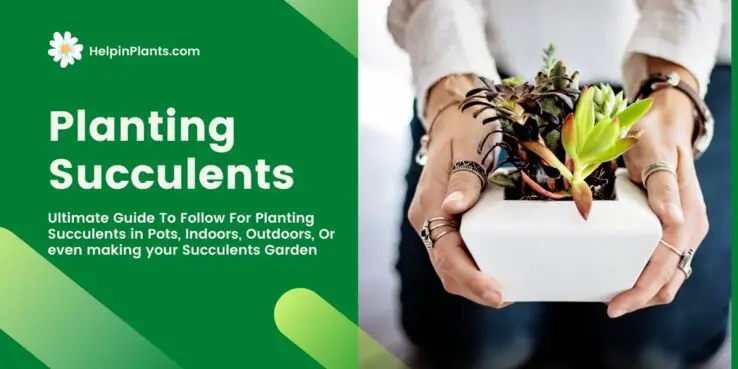
How to plant succulents - Step by Step Process
Succulents are some of the most popular plants to grow indoors. They resist drought, are easy to maintain, have fleshy leaves, and come in a variety of shapes and eye catching colors that make them perfect for all types of spaces. But if you want your succulents thrive, it requires more than just watering once a week or so. You need to know how best to plant them!
The following is an overview of exactly what you need to do when planting succulents:
When to repot your succulent?
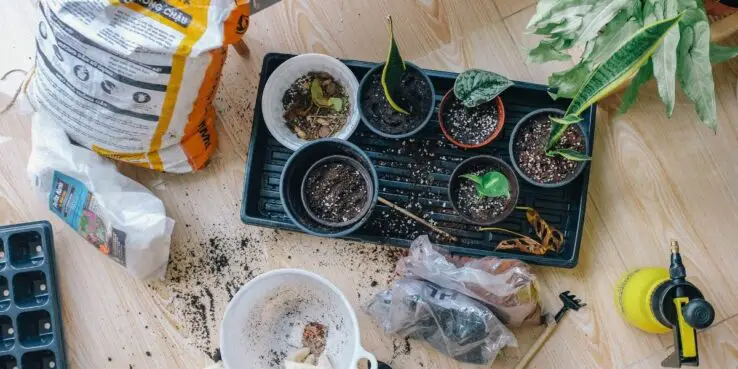
There are many times that you might want to repot your succulent. Some of them are discussed here.
Transplant your succulent when you buy from store
The first time that you'll need to repot your succulent is when you buy it from the store. Most succulents will come in small containers with little to no roots, and this is the first time that you'll want to give them bigger containers than what they came in. The goal here is to put your plant in something that its roots can grow in, so choose a container at least two inches larger all around than the one that it came in.
When you're repotting your succulent, look at its roots to determine what type of soil it's growing in. Usually, nurseries use organic soil that usually doesn't drain well. To do well, you'll need to provide it with good drainable soil.
This works well in the climate-controlled environment of a nursery, but it doesn't work as well once you bring succulents home. Oftentimes, you'll need to repot your succulents right after purchasing them into fresh soil instead.
Repot your succulent when it outgrows the pot

When your succulent outgrows the pot that it's in, you'll want to repot it so that its roots can grow more. Once the roots of your succulent have grown through the container's bottom hole (root bounding), it's ready to be placed in something larger.
Your goal when repotting your succulent is to provide it with fresh soil that will help its roots grow and stay healthy. This means using well-drained soil, like cacti mix or a mixture of sand and potting soil.
Best time to repot your succulents
The best time to repot a succulent is in the spring or fall or whatever your specific plant active growing season is. If you’re doing it for aesthetic purposes, like making beautiful hanging succulents arrangement, then you can also plant them in the winter and summer months. However, during these seasons, your indoor garden will require more attention.
Planting Succulents: Step by Step Process
I'll be going over the step-by-step process of planting succulents in containers.

Repotting your succulent plants is important because if they outgrow their containers, they won't have enough room for their roots to grow more and may eventually stop their growth from root bounding.
Here is the step-by-step process to plant succulents, i.e. succulents transplantation.
Step #1: Pull Your Succulent from the Old Pot
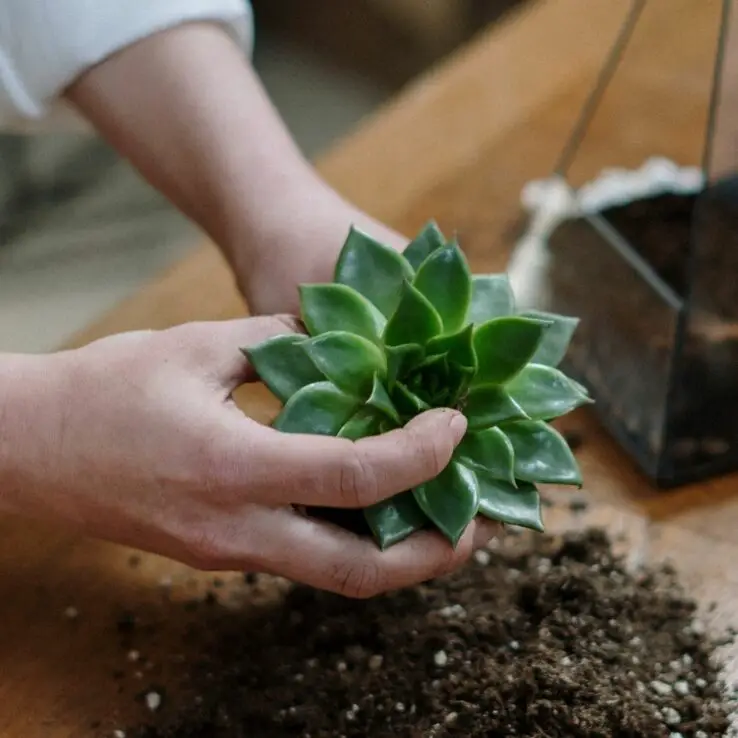
The first step of successful transplantation is removing your succulent from its old pot. Start by removing any dirt from around the root ball as gently as possible and then remove the plant carefully. Do not pull or tug too hard on it!
Once you've removed your plant, it's time to wash the roots gently, remove any dead ones (if you recognize them) at this time, and remove old soil completely or as much as possible.
Some people don't recommend washing your succulent roots to prevent root rot. But if you let it dry or avoid watering for 2-3 days after repotting, it'll heal up, and won't give you any issue.
Step #2: Prepare Your New Pot and Potting Soil
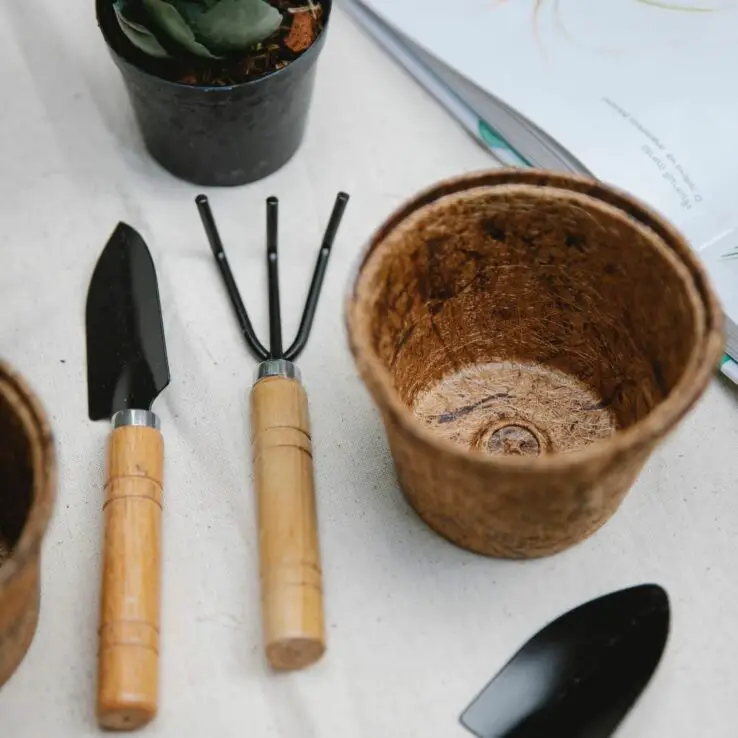
The new pot for your succulent should be larger than its existing pot, i.e. like 2 inches larger all around or so. Also, it is best to get a pot with a drainage hole. OR, drill by yourself in the bottom of the pot.
The soil should be a good draining, like, cacti/succulent plants mix or a mixture of sand and potting soil (1:1 ratio). Don't use regular garden or the same old nursery pot soil.
Step #3: Cover the Drainage Holes

Place a plastic window screen or a mesh over the drainage holes in your pot so the soil won't drain with water. Make sure that there is enough mesh over the drainage holes to cover them completely.
Alternatively, You can also place rocks/pebbles over the drainage holes of containers to cover them. This will keep the soil in place once you plant a succulent in.
Step #4: Fill the Pot with the New Potting Soil

Fill it almost to the top with your new well-drained soil and be careful not to compact it down firmly, as it should stay fluffy and airy instead.
Step #5: Place Your Succulent in its new Pot
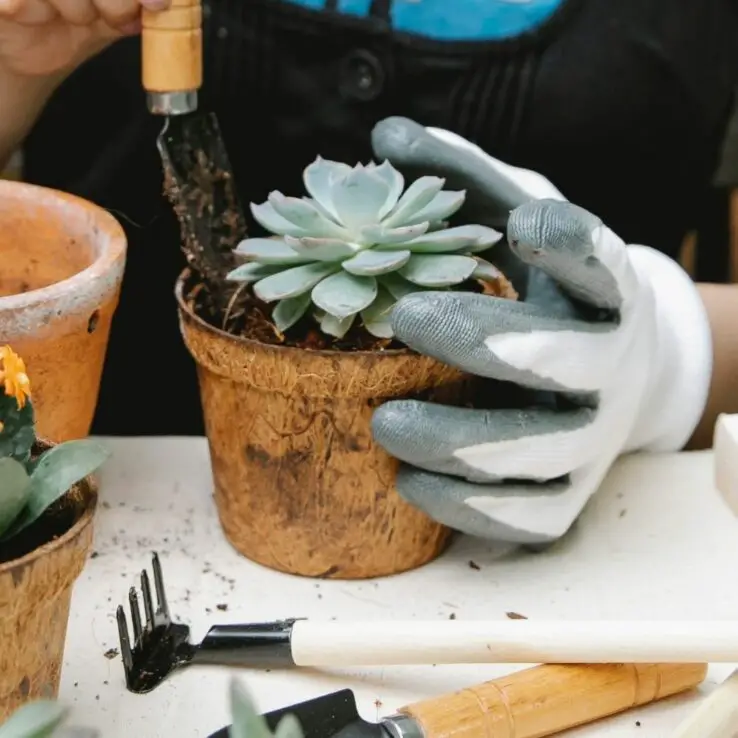
It's time to plant your succulent in its new home. Put it in the center of your pot and gently add more soil around it or push it down until its root ball is fully covered but keep the plant elevated.
This will allow enough space for drainage while also keeping its roots happy well-ventilated.
Planting your succulent on the top of your pot and spreading its roots almost horizontally, help it to grow easy, while still having plenty of space to strengthen its roots.
Step #6: Add Some Pebbles or Gravel for Decoration.
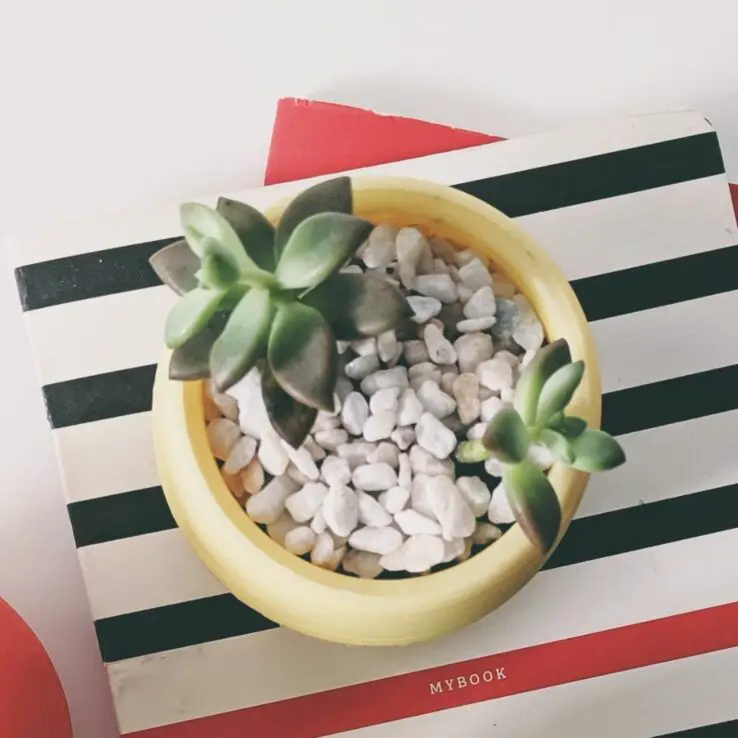
Now put a layer of top dressing, like gravel or coarse sand around the edge. This top dressing will help to prevent your soil from leaking out and it also provides some nice decoration for your succulent too.
The finished look will make you love succulents more.
Also, you can put your normal succulent pot inside a bigger decorative pot.
Step #7: Give the roots time to heal - (Most Important)
After adding your top dressing, leave your succulent without watering for up to 3 days. This will allow any damage to the roots from repotting to heal. The extra soil around it will protect it from drying out or losing moisture, so don't worry about your succulent not having enough water for a couple of days.
Once you're done with that, start watering it normally and continue doing so for a good 2-3 weeks to help the soil settle down.
During this time, you can give it more water than usual and a diluted dose of fertilizer as well. This helps to ensure that your plants' root systems settles in well.
Planting Succulent Container Garden: Step by Step Process
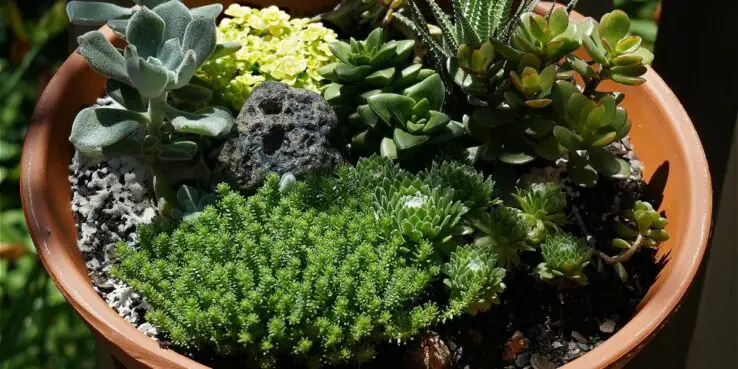
Succulent container gardening is perfect for beginners or people who like plants but don't have much time or space. While not all succulents can be grown together due to their different requirements. But many succulents have the same requirements. Those can be grown in a same pot to make a container garden.
What you'll need to get started
The following materials are needed to Grow Succulents in Containers project:
- Live Succulents
- Cactus or Succulent plant potting mix
- Large Container or Pot with drainage hole
- Pebbles/Gravel for top dressing
- Pre-mixed organic fertilizer for cacti & succulents.
Step #1: Get your supplies
First, gather all the required supplies. They might already be in your home, OR, you can easily get them at your local gardening center or even purchase them online.
The key to healthy succulent garden success is to get the right type of succulents, potting mix, and container.
Selecting Succulents
Choose the succulent varieties that have similar care needs so you can grow them in the one container. OR at least, be sure to choose succulents that are not too picky about drainage or watering needs.
Succulent plants should also have similar sunlight requirements as well - otherwise some plants might burn while others may feel plants stretching.
Using the right succulents potting mix
Like succulents type, choose the soil for your container carefully because this will determine how well your succulents grow. You want to select a potting mix that is lightweight, airy, and drains easily, but it should also hold moisture just enough so you don't have to water too often.
If you've used other succulents before, you probably know what kind works best with them already. The soil should provide plenty of drainage and air circulation too.
Choosing the perfect container
To make it easier to create your own succulent container garden, choose a container that already has bottom holes.
If your chosen container has no holes in it, drill some yourself if you want your succulents thrive. Because standing water can kill these plants.
Step #2: Cover the drainage holes of the Container
To prevent your soil from running out the drainage holes and creating a mess on your floor, cover them with plastic window screen, or mesh, or commercial pot screen, or even a piece of landscape fabric.
This will make it easier to drain excess water while still holding the soil mix.
Step #3: Add Succulent/Cactus Soil Mix
Now that your drainage holes are covered, it's time to add the soil for your succulent container garden.
Add potting mix up to 3/4 (almost to the top) of your container height. this will make it easier to plant succulents later. Plus, you'll have room for the decorative top dressing as well.
Step #4: Decide the spacing between your plants
To avoid overcrowding, decide the spacing between your succulents from start. You want to leave enough room for the plants to grow.
To get a sense of how far apart to space your plants, stick them in the container and arrange them. Adjust the plants until you're satisfied with the final result.
Step #5: Start Planting those Succulents
Its time to
- Take the succulents out of nursery pots
- Remove old soil from their roots
- Place them on the newly prepared container while maintaining the spacing between
- Just spread their roots horizontally, or dig them a little bit, this will encourage healthy growth of your succulents.
- Don't worry if some roots overlaps others from the beginning
- Then carefully spread additional potting mix around each plant up to the point where they were in their nursery pots. Fill all the gaps in between.
Step #6: Clean it up, and add some decoration
Clean the soil that is left on succulents leaves by wiping it with a soft brush, cloth, or simply blowing on the plants.
Finally, finish it off by adding a top dressing of pebbles or coarse materials like gravel, stones, glass, coarse sand, and marbles, on the surface of the soil.
Step #7: Care & Grow Succulents in Container Gardens
Now that you've finished planting your succulent container garden, it's time to provide them with the care they need. Follow these basic tips for growing healthy succulents:
- Water regularly, don't over-water. Avoid getting their leaves wet.
- Fertilize once a month with water-soluble, balanced houseplant fertilizer OR specially designed succulents fertilizer, starting from the beginning of spring. But avoid in dormant season.
- Keep it clean. Remove dead leaves, branches, and flower stalks as soon as you see them.
- Better put it in a place where it can get direct sunlight. It can be a sunny window, or your other plants garden center where it gets full sun.
To learn more check out this Ultimate Guide on how to properly grow and care for succulents indoor.
Once properly planted and cared for, your container garden will begin to flourish in no time at all.
Planting Succulents Outdoors: Step by Step Process
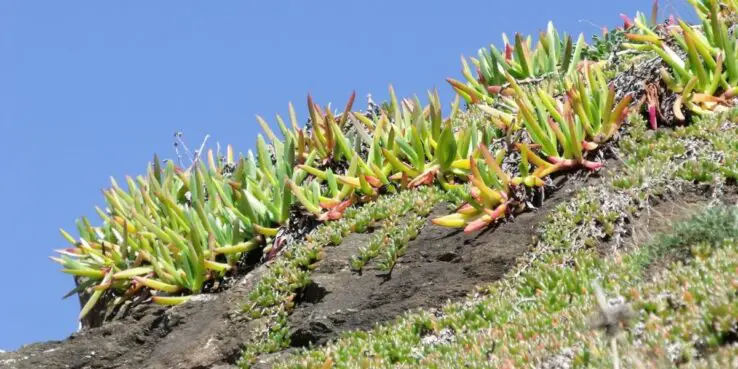
Outdoor conditions are not the same as those inside your home, especially, if you are planning to planting succulents in the ground. In the following quick steps, you'll get everything you need to know about.
Step #1: Find a suitable spot for your outdoors succulent garden
It should get enough sunlight (about 6 hours, but not too much sun) daily and well protected from strong winds. 'Drainage' is also an important factor for your succulents planting site. OR, it will lead to plant death, because wet soil may lead to root rot.
Finding the right place for outdoors succulent plants is important, Because its not like containers plants that can be brought indoors for protection from harsh weather.
So for growing succulents outdoors, it is better to choose a slope, or an elevated place in your existing garden center (if there is one), as it is good to prevent water from accumulating to keep your succulents alive.
Step #2: Preparing the ground
Before starting, remove all weeds and large debris in the area where you want to place your succulent garden. Then dig a hole twice the size of the nursery pot it currently planted in.
Also, incorporate some organic materials such as composted manure or peat moss into the ground before planting. This will improve drainage and provide nutrients that are essential for healthy growth of your succulents plants.
Like native habitats for most succulents you need a good-drained ground.
Alternatively, you can place a thick layer of aged compost over it, and then add a thin layer on top to cover everything.
Step #3: Plant Succulents in Outside Garden
Carefully remove your succulent plants from their nursery pots, try not to disturb root system. Then plant them out evenly within your pre-made hole in the prepared ground. Use enough soil to cover the plants to the point where they were previously planted in pots.
After planting your outdoor succulents garden, give it some days to adjust to its new environment without further disturbance. Then water once every week or 2, depending on your environment conditions. But remember, too much moisture can lead to root rot.
Step back and watch how they grow in this exciting new location!
Conclusion
Growing succulents can be a lot of fun, but it requires some attention as well. The good news is that you don't need green thumb, they are one of the most low-maintenance plants out there!
After reading through here, I assume, you'll have learned everything about planting your succulents indoors, outdoors, and in container gardens. Now it's time for you to take actions. Some easy-to-grow succulents include aloe ( Aloe spp. ), jade ( Crassula ovata ), and zebra cactus ( Haworthia spp. ), etc. Start from these, especially for outdoor conditions.
Let me know which planting method you choose for growing succulents in the comments below.
Also, if you find this article helpful please feel free to share it with your family and friends! Thanks for reading and hope you enjoyed it.

